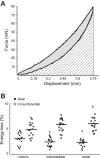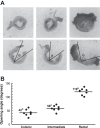Differential biomechanical properties of mouse distal colon and rectum innervated by the splanchnic and pelvic afferents
- PMID: 30702901
- PMCID: PMC6483024
- DOI: 10.1152/ajpgi.00324.2018
Differential biomechanical properties of mouse distal colon and rectum innervated by the splanchnic and pelvic afferents
Abstract
Visceral pain is one of the principal complaints of patients with irritable bowel syndrome, and this pain is reliably evoked by mechanical distension and stretch of distal colon and rectum (colorectum). This study focuses on the biomechanics of the colorectum that could play critical roles in mechanical neural encoding. We harvested the distal 30 mm of the colorectum from mice, divided evenly into three 10-mm-long segments (colonic, intermediate and rectal), and conducted biaxial mechanical stretch tests and opening-angle measurements for each tissue segment. In addition, we determined the collagen fiber orientations and contents across the thickness of the colorectal wall by nonlinear imaging via second harmonic generation (SHG). Our results reveal a progressive increase in tissue compliance and prestress from colonic to rectal segments, which supports prior electrophysiological findings of distinct mechanical neural encodings by afferents in the lumbar splanchnic nerves (LSN) and pelvic nerves (PN) that dominate colonic and rectal innervations, respectively. The colorectum is significantly more viscoelastic in the circumferential direction than in the axial direction. In addition, our SHG results reveal a rich collagen network in the submucosa and orients approximately ±30° to the axial direction, consistent with the biaxial test results presenting almost twice the stiffness in axial direction versus the circumferential direction. Results from current biomechanical study strongly indicate the prominent roles of local tissue biomechanics in determining the differential mechanical neural encoding functions in different regions of the colorectum. NEW & NOTEWORTHY Mechanical distension and stretch-not heat, cutting, or pinching-reliably evoke pain from distal colon and rectum. We report different local mechanics along the longitudinal length of the colorectum, which is consistent with the existing literature on distinct mechanotransduction of afferents innervating proximal and distal regions of the colorectum. This study draws attention to local mechanics as a potential determinant factor for mechanical neural encoding of the colorectum, which is crucial in visceral nociception.
Keywords: biaxial test; irritable bowel syndromes; mechanotransduction; second harmonic generation; visceral pain.
Conflict of interest statement
No conflicts of interest, financial or otherwise, are declared by the authors.
Figures








Similar articles
-
Load-bearing function of the colorectal submucosa and its relevance to visceral nociception elicited by mechanical stretch.Am J Physiol Gastrointest Liver Physiol. 2019 Sep 1;317(3):G349-G358. doi: 10.1152/ajpgi.00127.2019. Epub 2019 Jul 3. Am J Physiol Gastrointest Liver Physiol. 2019. PMID: 31268771 Free PMC article.
-
The heterogeneous morphology of networked collagen in distal colon and rectum of mice quantified via nonlinear microscopy.J Mech Behav Biomed Mater. 2021 Jan;113:104116. doi: 10.1016/j.jmbbm.2020.104116. Epub 2020 Oct 8. J Mech Behav Biomed Mater. 2021. PMID: 33049619 Free PMC article.
-
Differential roles of stretch-sensitive pelvic nerve afferents innervating mouse distal colon and rectum.Am J Physiol Gastrointest Liver Physiol. 2010 Mar;298(3):G402-9. doi: 10.1152/ajpgi.00487.2009. Epub 2010 Jan 14. Am J Physiol Gastrointest Liver Physiol. 2010. PMID: 20075141 Free PMC article.
-
Visceral pain from colon and rectum: the mechanotransduction and biomechanics.J Neural Transm (Vienna). 2020 Apr;127(4):415-429. doi: 10.1007/s00702-019-02088-8. Epub 2019 Oct 9. J Neural Transm (Vienna). 2020. PMID: 31598778 Free PMC article. Review.
-
The Macro- and Micro-Mechanics of the Colon and Rectum II: Theoretical and Computational Methods.Bioengineering (Basel). 2020 Nov 25;7(4):152. doi: 10.3390/bioengineering7040152. Bioengineering (Basel). 2020. PMID: 33255522 Free PMC article. Review.
Cited by
-
Layer-Specific Damage Modeling of Porcine Large Intestine under Biaxial Tension.Bioengineering (Basel). 2022 Oct 6;9(10):528. doi: 10.3390/bioengineering9100528. Bioengineering (Basel). 2022. PMID: 36290495 Free PMC article.
-
Computational Modeling of Mouse Colorectum Capturing Longitudinal and Through-thickness Biomechanical Heterogeneity.J Mech Behav Biomed Mater. 2021 Jan;113:104127. doi: 10.1016/j.jmbbm.2020.104127. Epub 2020 Oct 10. J Mech Behav Biomed Mater. 2021. PMID: 33125950 Free PMC article.
-
Galanin suppresses visceral afferent responses to noxious mechanical and inflammatory stimuli.Physiol Rep. 2020 Jan;8(2):e14326. doi: 10.14814/phy2.14326. Physiol Rep. 2020. PMID: 31960596 Free PMC article.
-
Mechanobiological considerations in colorectal stapling: Implications for technology development.Surg Open Sci. 2023 Apr 16;13:54-65. doi: 10.1016/j.sopen.2023.04.004. eCollection 2023 Jun. Surg Open Sci. 2023. PMID: 37159635 Free PMC article. Review.
-
Fabricating a Low-Cost, Microscopy-Compatible Mechanical Testing Device.Exp Tech. 2022 Oct;46(5):731-743. doi: 10.1007/s40799-021-00513-w. Epub 2021 Sep 28. Exp Tech. 2022. PMID: 39119455 Free PMC article.
References
Publication types
MeSH terms
Grants and funding
LinkOut - more resources
Full Text Sources

